#talbot county
Text

In Talbot County, MD: Drake 3 month old Cane Corso mix puppy
Drake is a 3-month-old Cane Corso mix puppy that was surrendered when his owner was moving and unable to bring him along, he sweet, fun, and adorable. He is nearly housetrained already and know sit. We want him to be successful and are reaching out to rescue in hopes that will be interested in pulling him. He is current on vaccines. He did display some guarding of food items during his evaluation
Please let me know if you have any questions.
Dayniese Hurley
Animal Care Supervisor
Talbot Humane
Phone: 410-822-0107
Fax: 410-822-7619
Email:[email protected]
#dog rescue#dog rescue baltimore maryland#dog rescue maryland#cute animals#doglover#puppies#cane corso#pets#Talbot County
2 notes
·
View notes
Text
51 years later: Anna Marie Tilghman's widows pension

Tench Tilghman's gravestone, courtesy of Wikimedia.
Fifty-one years after Tench Tilghman's death, his wife (who was a cousin), Anna Marie Tilghman, got a widows pension. Tilghman was, as the Maryland State Archives argues, "one of Maryland's great patriots" due to his public service as part of a "commission established to form treaties with the Six Nations of Indian tribes," a captain in "the Pennsylvania Battalion of the Flying Camp.," and serving as an unpaid aide-de-camp to George Washington from August 1776 to May 1781 when Washington got him "a regular commission in the Continental Army." His final task was "he honor of carrying the Articles of Capitulation to the Continental Congress in Philadelphia." Other than that, the Maryland State Archives writes that Tench was
born on December 25, 1744 in Talbot County on his father's plantation. He was educated privately until the age of 14, when he went to Philadelphia to live with his grandfather, Tench Francis. In 1761, he graduated from the College and Academy of Philadelphia, which later became the University of Pennsylvania, and then went into business with his uncle Tench Francis, Jr. until just before the Revolutionary War. After the War, Tilghman returned to Maryland where he resumed his career in business in Baltimore and married his cousin, Anna Marie Tilghman. They had two daughters, Anna Margaretta and Elizabeth Tench. Tilghman died on April 18, 1786 at the age of 41.
His gravestone was placed in Talbot County's Oxford Cemetery long after his death. That's because he died at St. Paul's Church in Baltimore, with the remains brought from there to Talbot County in 1971 but the original gravestone, without the plaque, does tell something about him.
The widows pension by Anna Maria Tilghman tells an interesting story. [1] The first page shows that not only is it a penson for Anna Maria but that Tench also received a land grant, with "B.L.W.T." noting an "application for a warrant for bounty land" promised to him since he "served to the end of the war":

The next page notes that Tench died on April 18, 1786 in Talbot County, MD and was a Lieutenant Colonel serving in the army commanded by General George Washington, specifically in the Pennsylvania line, for two years. This is despite the fact he served for longer than two years as noted earlier in this article. For all of this, she would receive almost $4,000.00 a year, a sizable sum at the time when she was filing (May 1843):

The next page doesn't say much else other than that her claim would be processed in Maryland under the 1836 Pension Act covering veterans of the war with Britain from 1812-1815 and the Revolutionary War:

The page following is a personal appeal by her on February 24, 1837 in which she, before the Talbot County Orphans Court notes that she is the widow of Tench who serves as an Aide to Camp to George Washington and Lt. Colonel in the PA line, serving in total from January 1, 1777 to November 3, 1783. She also notes that she married Tench on June 9, 1783, and that he died on April 18, 1786:

The next page is a judge on the Orphans Court in Talbot County, James Price, certifying her declaration is correct, nothing more, nothing less:
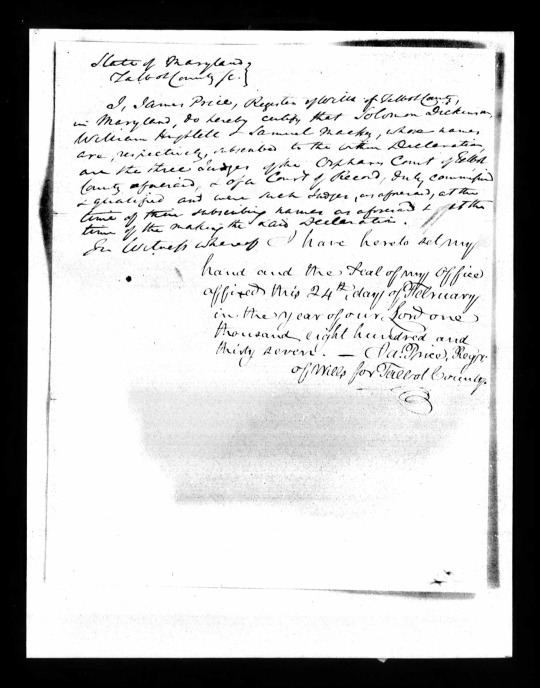
Then on March 11, 1837 a 82-year-old woman named Henrietta Maria Francis appeared before the Talbot County Orphans Court. She said she was "well acquainted with Col Tench Tilghman of Baltimore City," noting that she first met him in 1780, noting that through the years it was recounts how he was an aide-de-camp of George Washington. She was also, of course, familiar with Anna Maria Tilghman, saying that she was the daughter of one Matthew Tilghman, noting also that they were both married in June 1783. Clearly she was related on a familial level to Tench: her husband, Philip Francis, was Tench's uncle, whom Tench visited in March 1783 after their marriage.
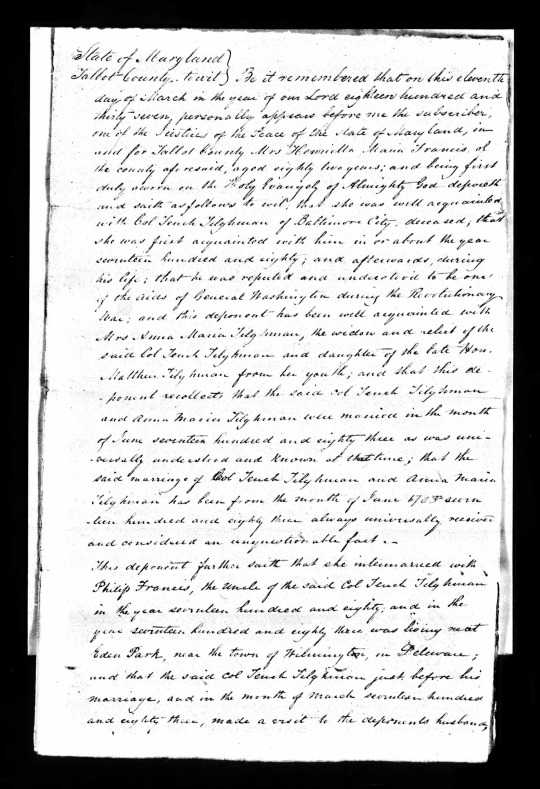
She adds that Tench died three years after she married Philip Francis, with Anna Maria (called she after this section) having one daughter before Tench's death, and another after Tench died (she must have been in labor when Tench died), and has since stayed as a widow. Others writing below her attest to the veracity of this statement:

By October 1858 it is asserted that Anna Maria died in 1843, with another Tilghman (M. Tilghman Goldborough) filing a continuing claim as they inherited her estate interestingly:
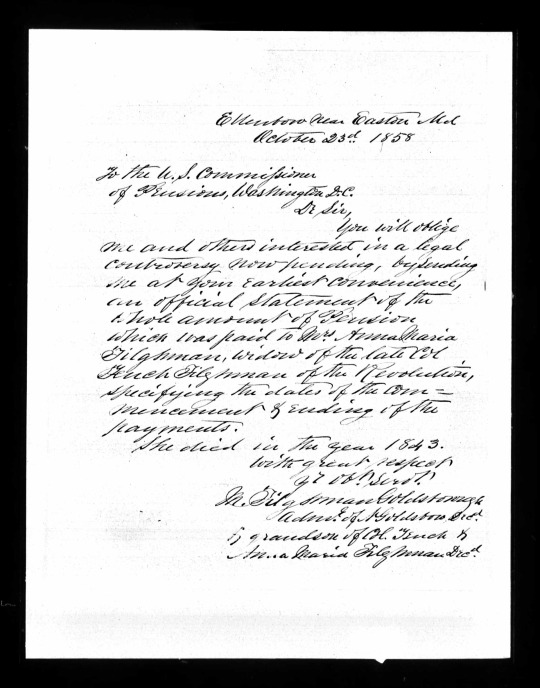
From there, Elizabeth Goldborough, likely the mother of the above listed M. Tilghman Goldsborough, turns out to be the daughter of Anna Maria and Tench! It is also noted that her sister is named Margaret who died, leaving her the only heir. This document, issued by a Talbot County Justice of the Peace in December 1825, shows that Margaret and Elizabeth were children of Anna Maria and Tench Tilghman without a doubt:
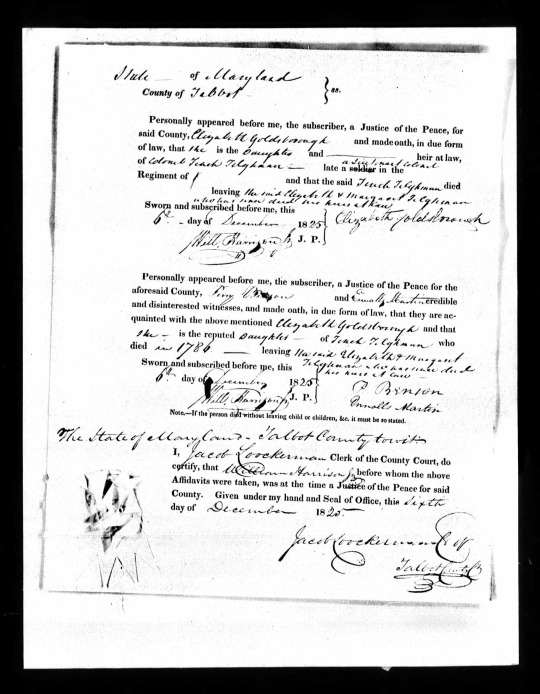
The pension goes on to say that Elizabeth is an heir of Tench Tilghman, and quickly notes Tench's military service:
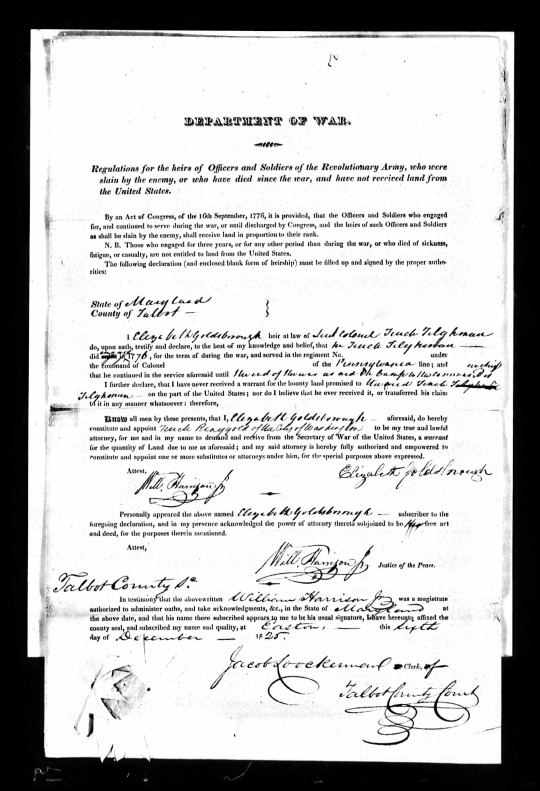
The next page makes it clear that all of those previous pages specifically related to a bounty land warrant claim, which is wrapped up within the pages of Tench's pension papers, making it possible for Tench's wife Anna Maria to apply for a widows pension in 1837 and Elizabeth to apply for the bounty land warrant in 1825, for her son to come back in the 1850s saying that now want to apply for the pension. This page makes it clear that Elizabeth's request was granted in January of 1826:
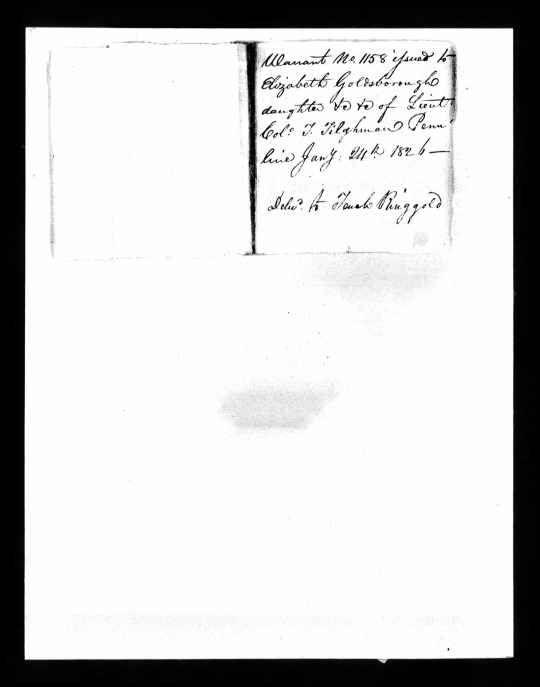
In May 1929, the War Department tried to sort all of this out. As they summarized, it was clear that Tench served from January 1, 1777 to November 3, 1783 as a Lieutenant Colonel in the Continental Army and an aide-de-camp to General Washington, dying on April 18, 1783. They also summarized how Tench married Anna Maria on June 8, 1783, allowed a pension on February 13, 1837but died on January 18, 1843. They also wrote that they had two children, Elizabeth and Margaret with the former child marrying a man named Goldsborough of Talbot County, Maryland, while the latter had a son named Tench Tilghman, marrying a man whose name is not yet known.

The final page says that a "grandson" named M. Tilghman Goldsborough is referred to in 1858 but no other family data is known.

The next page just notes Anna Maria's widows pension claim:

In May 1843, a man named Tench Tilghman said that he obtained a pension claim for a Mrs. Anna Maria Tilghman, widow of Tench in 1837, noting that Anna Maria died January 13, 1843 at age 88, if I read that right. He further notes that the youngest daughter of Anna Maria and Tench, Elizabeth ("Mrs. C.T. Goldsborough"), who was noted earlier, is an heir, while he is the son of the the older daughter, Margaret. As such, he asks the pension commissioner to whom the pension now belongs:
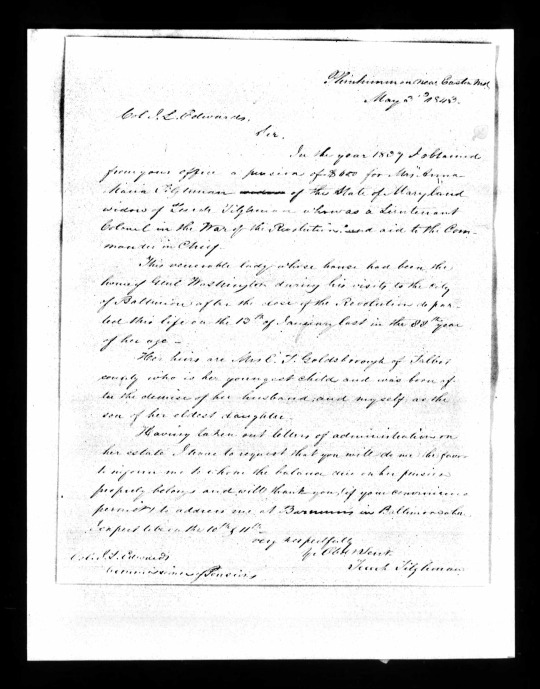
Then there is an earlier letter from J.L. Edwards, the pension commissioner in March 1837, saying that the papers in the case of the pension are returned as the evidence is "not being sufficient to establish the claim" because of new regulations on pensions. Perhaps this is what prompted the second Tench's letter in 1843, for which a response is not known:

A further letter from J.L. Edwards, in March 1837, confirms that Tench did serve from January 1, 1777 to November 3, 1783:
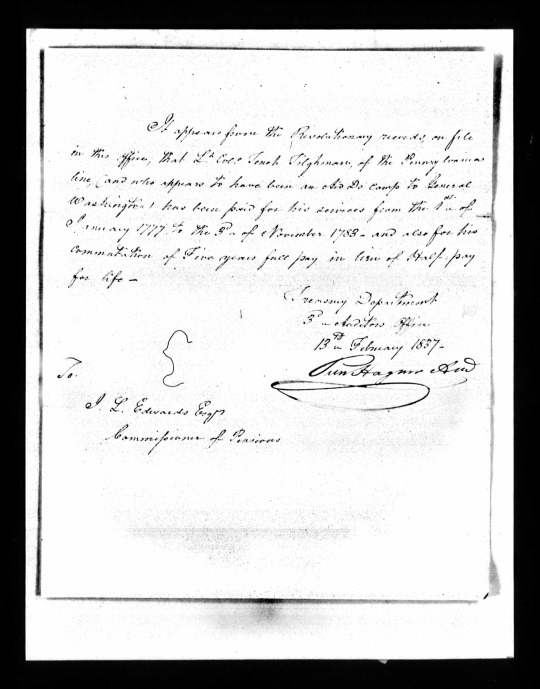
Then there is a letter from a later descendant in 1894 to the pension office about Tench's pension papers:

After that there is a 1928 letter by another descendant, Grace Cottingham Tilghman Bowen (who married a man named Charles Hay Bowen), leading to the response from the War Department as noted earlier in this post:
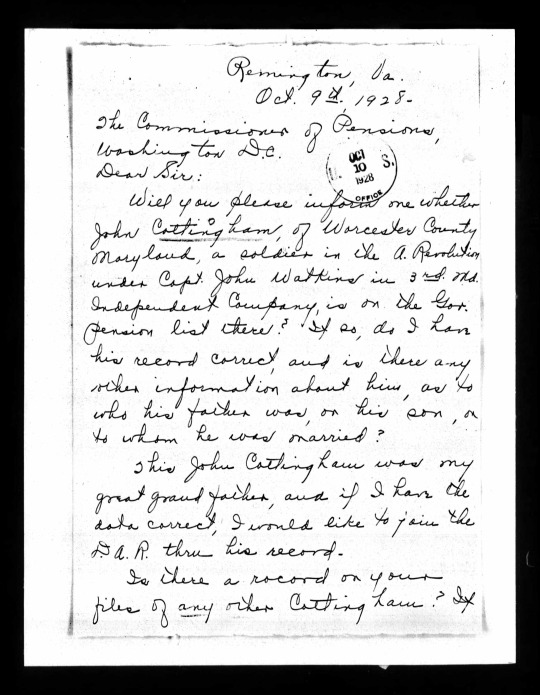
The second page specifically focuses on Tench:
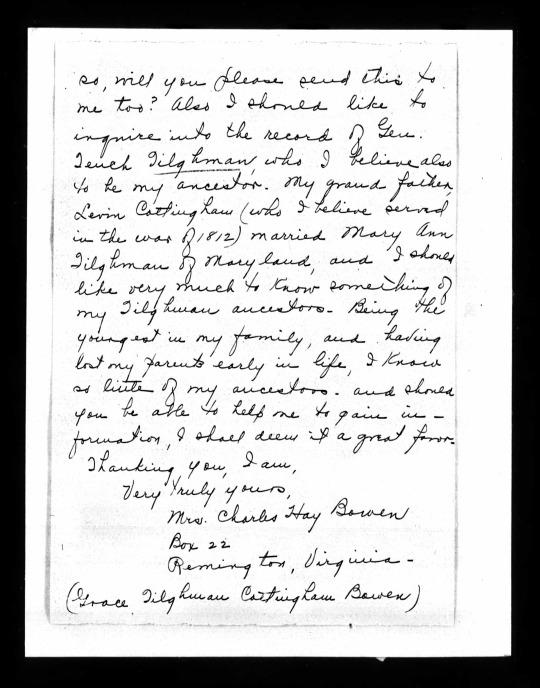
There is much to be learned from this pension. For one, that Tench served as a Lt. Colonel and Aide-De-Camp from 1777 to 1783, and that he married Anna Maria Tilghman, his cousin, in June 1783 when she was 28 years old (born in 1755). Furthermore, it is also clear that he had two children with her, Margaret (older) and Elizabeth (younger), with the latter child born after the "demise of her husband" Tench. From there, Margaret later had a child named Tench Tilghman, meaning that she married a person with the surname of Tilghman, while Elizabeth married a man named C.T. Goldsborough and seemingly had a child named M. Tilghman Goldsborough. It is not known when Margaret or Elizabeth died, but only that Margaret was dead sometime before 1825 (when Elizabeth filed her claim for the bounty land), while Elizabeth lived until at least 1843. Furthermore, it is also noted that Tench lived in Baltimore where he met a woman named Henrietta Maria Francis, who was 25 when she was first "acquainted" with Tench, and she married a man named Philip Francis,the uncle of Tench, whom Tench visited in March 1783 after the marriage of Henrietta and Philip. All of this calls for another post to dig into this more, which will be coming to you from this wonderful blog next week!
© 2017-2023 Burkely Hermann. All rights reserved.
Notes
[1] Pension of Tench Tilghman, 1837, B.L.Wt 1158-450, Widow's Pension Application File, W.9522, Revolutionary War Pension and Bounty-Land Warrant Application Files, National Archives, NARA M804, Record Group 15. Courtesy of Ancestry.com and Heritage Quest.
#gravestones#tench tilghman#wikimedia#pensions#military service#land grants#landowner#revolutionary war#american revolution#1830s#1780s#1770s#talbot county#marriage#cousins#estate#1850s#1840s#bounty land warrant#1820s#1890s#1920s
2 notes
·
View notes
Text
On Tuesday April 23, 2024 at 6:00 pm in the meadow beside the GOP Headquarters on Glebe Road in Easton, citizens of Talbot County gathered to eat pizza and cookies, socialize, buy Trump t-shirts and listen to speeches from three of our elected officials. It was slightly chilly and windy but a spectacularly lovely clear evening with over sixty guests present. The "Pizza and Politics" evenings occur once a month and are the brainchild of Talbot County Republican Central Committee member Lori Stepp, who certainly knows where to get the best pizza in town. But the main success is that it is an evening for concerned citizens to recreate and talk with their elected officials about the issues of the day.
The invited speakers were State Senator Johnny Mautz (District 37), Delegate Chris Adams (District 37B), and Delegate Tom Hutchinson (District 37B). Delegate Adams spoke about about the challenges of being a Republican in a Democrat run run House under Democrat Governor Wes Moore. Governor Moore continues to raise taxes, driving the Maryland economy into the ground. The departments of the Maryland executive branch have been weaponized against the citizens by going after small businesses, looking for reasons to fine them so as to fill the state coffers. We must demand accountability from our governor, as well as support for law enforcement, as crime is surging throughout the state, especially in Baltimore.
0 notes
Photo

Library - Traditional Living Room
Living room library - mid-sized traditional enclosed dark wood floor living room library idea with gray walls, a standard fireplace, a stone fireplace and no tv
1 note
·
View note
Text
Almost Identical Twins
The entrance gateway to the now-demolished Lissadorn, County Roscommon. Extant photographs show this to have been a fine house of three bays and three storeys over raised basement, possibly late 18th or early 19th century in construction. The design of this neoclassical triple archway, thought to date from c.1825, has been attributed to the Roscommon architect Richard Richards, not least because…

View On WordPress
#Architectural History#County Roscommon#Georgian Architecture#Heritage at Risk#Lissadorn#Mount Talbot#Triumphal Arch
4 notes
·
View notes
Text
Eastern Shore Town Hall
Image ID: Eastern Shore Town Hall. Maryland Department of Disabilities is gathering input from the disability community to create the next State Disabilities Plan and determine priorities for the next plan. Share your thoughts and experiences! To the right is a photo of disabled people with varying disabilities.
You can download the PDF here via Google Drive to share with your networks and…

View On WordPress
#Cecil County MD#CIL#Disability Forum#Disabled#Disabled Marylanders#Eastern Shore#Eastern Shore MD#Eastern Shore Town Hall#Kent County MD#Maryland#Maryland Department of Disabilities#Maryland State Disabilties Plan#MD#MDOD#Queen Annes County MD#Rural Disability#Rural Marylanders#Somerset County#Talbot County MD#Town Hall#Wicomico County MD#Worcester County MD
0 notes
Text
We are providing medical equipment repair & services in Talbot County MD, with the top quality at an affordable price. To know more, read the full post.
0 notes
Text
Aberdulais Falls, Wales
Aberdulais Falls in May 2018
My husband and I visited a number of waterfalls when we visited Wales in May 2018. Some of the falls we found on a strenuous 8 mile hike. Others, like Aberdulais Falls, were rather easy to visit. I think we did pass the parking lot and realized that we needed to turn around.
We stayed in Neath as there were waterfalls nearby and Brecon Beacons National Park isn’t…

View On WordPress
#Aberdulais Falls#National Trust#nature#Neath#Neath Port Talbot County#outdoors#Swansea#United Kingdom#Wales#waterfall
0 notes
Text

| DEMO TBA | RO INTROS |
| playlists | pinterest |
Welcome back to Misty Cove!
Your hometown that holds all of your best memories from childhood. Days where you spent all of your time with friends, exploring and playing. The most notable thing about both you and your hometown however, is what started happening in your teenage years. After you and your friends uncovered a mystery about the local movie theater, you starting finding more odd occurrences across the county, and well, it's not like anybody else was going to solve them.
You and your friends because a team of detectives. Most your teenage years and early twenties were spent solving odd crimes across the country. You were all best friends.
That was until four years ago when...
Well, you're not sure you can remember anymore.
It doesn't matter right now. Welcome back.
'Return to Misty Cove' is a horror/mystery Interactive Fiction game that is inspired by Scooby-Doo, The Works of Stephen King, and H.P. Lovecraft. This work will be rated 17+ for gore, violence, swearing, death, and body horror, that might not be suitable for everyone.

Customize your MC's appearance, develop their personality and become the linchpin of your mystery solving team.
Find out more and possibly solve the mystery that has been haunting your hometown.
Rekindle, or destroy old friendships (and maybe develop romances) with your former team, and meet others along the way.
Have an animal companion! (dog or cat)

RO's & Other Major Characters
Cameron "Cam" Morris (M/F) [RO]- Tech-savvy and mechanically minded, Cam is currently working as a mechanic after you and your group broke up, they are currently going to grad school for mechanical engineering, and still sends postcards and pictures to you. They are likely the sweetest person you have ever met, even if sometimes they are too kind to people who don't deserve it. Out of the four of you, Cam was always the one who needed to do what was right, no matter the cost to their self.
Ollie Cohen-Reyes (NB) [RO]- Ollie has always been interested in macabre and strange, spending hours researching in the library any and every topic they were interested in. They get along with very few people, but once they are able to get close with others it becomes easier, and they become sarcastic and witty, and feel less uncomfortable talking about their interests freely. They work as an adjunct professor in forensic anthropology.
Rose/Rory Thompson(M/F) [RO]- They are a loyal person, first and foremost. When the group broke up they somewhat lost their purpose, but they ended up settling and working as a bartender in Misty Cove. Having taken boxing and self-defense classes from a young age due to their paranoid parents, R was always the best when it came to physical confrontation with the cases you investigated, even if outside of this they never seemed like someone who had that much power. They have become far more aggressive and assertive than the person you knew as a child, now having the attitude to match their technical know-how.
Terra Clarke (F) [RO]- You originally knew her by a different name, but she started transitioning early on life, and Terra is the only name you can remember now. Normally when you say it it's followed by an eye roll. Terra was never someone you got along with when you lived in Misty Cove. She was always very antagonistic towards you and your friends, but a lot has changed since the last time you saw her. She now owns her Grandpa's diner, and tries to take good care of the people of the town, especially since the mayor won't do much. She is always exhausted now, but is very happy to see a familiar face, even if your history is muddied because of both of your actions.
Randall 'Randy' Clarke - Terra's grandfather and former owner of "Randy's Diner" always very kind to you and your friends, even if you all never got along with Terra.
Ana Lloyd - (pronounced AH-na) current mayor and overall very unprepared for her job.
Mrs. Candace Talbot- Your former English teacher from high school, you never got along with her that well.
Dorothy Giles- Your co-worker, likely the only one in your office who cares about her job.
(most things are subject to change throughout the games development)
#interactive fiction#interactive novel#intro post#misty cove-if#if wip#twine if#second try for the intro post#I learned how to code to make this game out of spite#misty cove if
303 notes
·
View notes
Text

Simbi water spirits are revered in Hoodoo originating from Central African spiritual practices. When Africans were enslaved in the United States, they blended African spiritual beliefs with Christian baptismal practices. Enslaved African Americans prayed to Simbi water spirits during their baptismal services. In 1998, in a historic house in Annapolis, Maryland called the Brice House archaeologists unearthed Hoodoo artifacts inside the house that linked to the Kongo people. These artifacts are the continued practice of the Kongo's minkisi and nkisi culture in the United States brought over by enslaved Africans. For example, archeologists found artifacts used by enslaved African Americans to control spirits by housing spirits inside caches or nkisi bundles. These spirits inside objects were placed in secret locations to protect an area or bring harm to slaveholders. "In their physical manifestations, minkisi (nkisi) are sacred objects that embody spiritual beings and generally take the form of a container such as a gourd, pot, bag, or snail shell. Medicines that provide the minkisi with power, such as chalk, nuts, plants, soil, stones, and charcoal, are placed in the container." Nkisi bundles were found in other plantations in Virginia and Maryland. For example, nkisi bundles were found for the purpose of healing or misfortune. Archeologists found objects believed by the enslaved African American population in Virginia and Maryland to have spiritual power, such as coins, crystals, roots, fingernail clippings, crab claws, beads, iron, bones, and other items assembled together inside a bundle to conjure a specific result for either protection or healing. These items were hidden inside slaves' dwellings. These practices were concealed from slaveholders.

In Darrow, Louisiana at the Ashland-Belle Helene Plantation historians and archeologists unearthed Kongo and Central African practices inside slave cabins. Enslaved Africans in Louisiana conjured the spirits of Kongo ancestors and water spirits by using seashells. Other charms were found in several slave cabins, such as silver coins, beads, polished stones, bones, and were made into necklaces or worn in their pockets for protection. These artifacts provided examples of African rituals at Ashland Plantation. Slaveholders tried to stop African practices among their slaves, but enslaved African Americans disguised their rituals by using American materials and applying an African interpretation to them and hiding the charms in their pockets and making them into necklaces concealing these practices from their slaveholders. In Talbot County, Maryland at the Wye House plantation where Frederick Douglass was enslaved in his youth, Kongo related artifacts were found. Enslaved African Americans created items to ward off evil spirits by creating a Hoodoo bundle near the entrances to chimneys which was believed to be where spirits enter. The Hoodoo bundle contained pieces of iron and a horse shoe. Enslaved African Americans put eyelets on shoes and boots to trap spirits. Archaeologists also found small carved wooden faces. The wooden carvings had two faces carved into them on both sides which were interpreted to mean an African American conjurer who was a two-headed doctor. Two-headed doctors in Hoodoo means a conjurer who can see into the future and has knowledge about spirits and things unknown.

At Levi Jordan Plantation in Brazoria, Texas near the Gulf Coast, researchers suggests the plantation owner Levi Jordan may have transported captive Africans from Cuba back to his plantation in Texas. These captive Africans practiced a Bantu-Kongo religion in Cuba, and researchers excavated Kongo related artifacts at the site. For example, archeologists found in one of the cabins called the "curer's cabin" remains of an nkisi nkondi with iron wedges driven into the figure to activate its spirit. Researchers found a Kongo bilongo which enslaved African Americans created using materials from white porcelain creating a doll figure. In the western section of the cabin they found iron kettles and iron chain fragments. Researchers suggests the western section of the cabin was an altar to the Kongo spirit Zarabanda

#zarabanda#bilongo#nkisi nkondi#bantu kongo#cuba#texas#levi jordan#african#afrakan#kemetic dreams#africans#african culture#afrakan spirituality#afrakans#frederick douglass#Ashland-Belle Helene Plantation#Darrow#Louisiana#simbi#water#water spirit#baptism#christianity#christian broadcasting network#christian living#christian doctrine#christian faith#hoodoo#vodun#voodoo
173 notes
·
View notes
Text
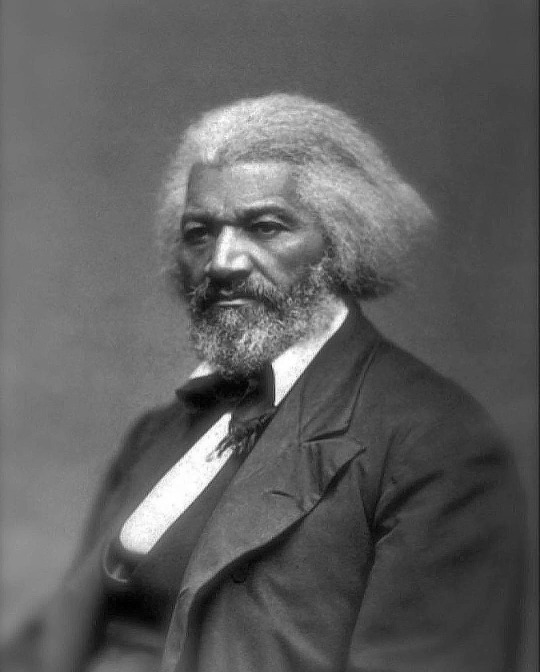
Today In History
Frederick Douglass was born around 1818 into slavery in Talbot County, Maryland. As was often the case with slaves, the exact year and date of Douglass’ birth are unknown, though later in life he chose to celebrate it on February 14.
In his journey from captive slave to internationally renowned activist, Frederick Douglass has been a source of inspiration and hope for millions of African Americans.
His brilliant words and brave actions continue to shape the ways that we think about race, democracy, and the meaning of freedom.
“The rich inheritance of justice, liberty, prosperity and independence, bequeathed by your fathers, is shared by you, not by me. The sunlight that brought life and healing to you, has brought stripes and death to me. This Fourth of July is yours, not mine. You may rejoice, I must mourn.” - insert from Frederick Douglass, “What, To The Slave, Is The Fourth Of July.”
He was the most photographed American of the nineteenth century.
CARTER™️ Magazine
#frederick douglass#carter magazine#carter#historyandhiphop365#wherehistoryandhiphopmeet#history#cartermagazine#today in history#staywoke#blackhistory#blackhistorymonth
88 notes
·
View notes
Text








🌈 Good morning and happy Wednesday, my bookish bats! You didn't think that tiny "queer books coming out this fall" guide was ALL there was, did you? Here are a FEW of the stunning, diverse queer books you can add to your TBR this month. Happy reading!
❤️ A Vision of Air by Nicole Silver
🧡 Eli Over Easy by Phil Stamper
💛 How to Get Over the End of the World by Hal Schrieve
💚 Kween by Vichet Chum
💙 The Forest Demands its Due by Kosoko Jackson
💜 The B-Side of Daniel Garneau by David Kingston Yeh
❤️ Midnight Companion by Kit Barrie
🧡 Let the Waters Roars by Geonn Cannon
💛 Into the Glittering Dark by Kelley York
💙 When the Rain Begins to Burn by A.L. Davidson
💜 Been Outside by Amber Wendler & Shaz Zamore
🌈 The Forest Demands Its Due by Kosoko Jackson
❤️ A Necessary Chaos by Brent Lambert
🧡 The Spells We Cast by Jason June
💛 Pluralities by Avi Silver
💚 Salt the Water by Candice Iloh
💙 Beholder by Ryan La Sala
💜 This Pact is Not Ours by Zachary Sergi
❤️ Dragging Mason County by Curtis Campbell
🧡 Menewood by Nicola Griffith
💛 Mary and the Birth of Frankenstein by Anne Eekhout
💚 The Dead Take the A Train by Cassandra Khaw & Richard Kadrey
💙 Bloom by Delilah S. Dawson
💜 Let Me Out by Emmett Nahil and George Williams
🌈 In the Form of a Question: the Joys and Rewards of a Curious Life by Amy Schneider
❤️ Songs of Irie by Asha Ashanti Bromfield
🧡 A Haunting on the Hill by Elizabeth Hand
💛 Being Ace by Madeline Dyer
💚 Charming Young Man by Eliot Schrefer
💙 The Glass Scientists by S.H. Cotugno
💜 The Fall of Whit Rivera by Crystal Maldonado
❤️ By Any Other Name by Erin Cotter
🧡 Brooms by Jasmine Walls and Teo DuVall
💛 Stars in Your Eyes by Kacen Callender
💚 Shoot the Moon by Isa Arsen
💙 The Bell in the Fog by Lev A.C. Rosen
🌈 Brainwyrms by Alison Rumfitt
❤️ Family Meal by Bryan Washington
🧡 A Murder of Crows by Dharma Kelleher
💛 A Light Most Hateful by Hailey Piper
💚 Love at 350° by Lisa Peers
💙 Greasepaint by Hannah Levene
💜 The Christmas Swap by Talia Samuels
❤️ Mate of Her Own by Elena Abbott
🧡 Mistletoe and Mishigas by M.A. Wardell
💛 Elle Campbell Wins Their Weekend by Ben Kahn
💚 All That Consumes Us by Erica Waters
💙 If You’ll Have Me by Eunnie
❤️ Tomorrow and Tomorrow by Lillah Lawson and Lauren Emily Whalen
🧡 10 Things That Never Happened by Alexis Hall
💛 It’s a Fabulous Life by Kelly Farmer
💚 Let the Dead Bury the Dead by Allison Epstein
💙 These Burning Stars by Bethany Jacobs
💜 The Goth House Experiment by SJ Sindu
❤️ Everything I Learned, I Learned in a Chinese Restaurant by Curtis Chin
🧡 Mudflowers by Aley Waterman
💛 Here Lies Olive by Kate Anderson
💚 Fire From the Sky by Moa Backe Åstot, trans. by Eva Apelqvist
💙 Iris Kelly Doesn’t Date by Ashley Herring Blake
💜 On the Same Page by Haley Cass
❤️ A Dish Best Served Hot by Natalie Caña
🧡 Art of the Chase by Jennifer Giacalone
💛 The Haunting of Adrian Yates by Markus Harwood-Jones
💚 The Sword: Xcian by Elle Arroyo
💙 The Complete Carlisle Series by Roslyn Sinclair
💜 300,000 Kisses by Sean Hewitt and Luke Edward Hall
❤️ Just a Pinch of Magic by Alechia Dow
🧡 Blackouts by Justin Torres
💛 Wrath Becomes Her by Aden Polydoros
💚 Let the Woods Keep Our Bodies by E.M. Roy
💙 Everything Under the Moon: Fairy Tales in a Queerer Light edited by Michael Earp
❤️ Frost Bite by Angela Sylvaine
🧡 We Met in a Bar by Claire Forsythe
💛 Sweat Equity Aurora Rey
💚 Pumpkin Spice by Tagan Shepard
💙 The Misfit Mage & His Dashing Devil by M.N. Bennet
💜 Love and Other Risky Business by Sarah Brenton
❤️ Enough by Kimia Eslah
🧡 A Fire Born of Exile by Aliette de Bodard
💛 Twelve Bones by Rosie Talbot
💚 Wild Wishes and Windswept Kisses by Maya Prasad
💙 Dragged to the Wedding by Andrew Grey
💜 Fox Snare by Yoon Ha Lee
❤️ Murder and Manon by Mia P. Manansala
#queer book recs#queer fiction#queer books#queer#books#book list#books to read#lgbt writers#batty about books#battyaboutbooks
54 notes
·
View notes
Text
From one Tilghman to the next: Tench and his descendants [Part 1]

As noted by the Maryland State Archives, this painting by Charles Wilson Peale for the Maryland State Archives, "Peale added two figures to the foreground of his composition. The first, to Washington's immediate left...The second figure Peale added is Lieutenant Colonel Tench Tilghman (1744-1786), a Marylander who served as Washington's military secretary and aide-de-camp, who is shown in profile. Tilghman's portrait was painted from life."
As we wrote about about last week on this blog, the pension for Anna Maria Tilghman, the widow of Tench Tilghman, is stock-filled with information. This post aims to dig into that information even more. Tench's military career is evident without a doubt, and was part of the focus of my poster board in 2007 for the History Day competition titled "Tench Tilghman Pays a Price for Being a Patriot," for which I only got to the state level with their theme of "Triumph & Tragedy in History." That is part of the reason I'm writing these posts to be honest, to rekindle my interest in the subject I explored all those years ago, even though I did go to the Maryland State Archives, Maryland Historical Society (MHS), Historical Society of Talbot County, and the Library of Congress. [1] Back then I wrote about how I took notes from copies of original letters and documents at the MHS, a photograph of Tench Tilghman's uniform, and that Tench came from a privileged family with sympathies toward the British crown, eventually making "sacrifices for Patriotism, facing estrangement from his family and disease contracted in battle," leading to his early death at the age of 41.
Reprinted from my History Hermann WordPress blog.
Tench during the Revolutionary War and after
As far back as May 1769, George Washington was on good terms with the Tilghman family. He wrote James Tilghman, Tench's father (who was once written about by the Maryland State Archives), that year, asking for advice in getting "Entrys of Land for me, near the Settlement of Redstone, in the Provence of Pensylvania" since he was, at the time, "anxious of obtaining some little possession in a Country that I have experienced many toils and hardships in." Then in September 1774, Washington "dined at Mr. [James] Tilghman’s" house in Talbot County, Maryland. By 1776, Tench was translating letters in French for Washington as indicated here and here. By August, he had brought a deserter to George Washington himself! In all, within Founders Online, are 78 letters from Tilghman to other individuals, sometimes Washington. As the National Park Service puts it, "at Valley Forge, almost 30% of the correspondence that came out of Washington’s headquarters was written by Tilghman." That's an amazing feat!
On March 19, 1784, Tench wrote from Baltimore, saying that there are not any bricklayers but only carpenters, to Washington's Mt. Vernon as noted in other letters. So, he is basically a caretaker of Mt. Vernon? In a letter a few months later he added that Irish servants arrived, saying the following:
I shall attend to your direction of substituting a Stone Mason in the room of a Bricklayer, should circumstances require it—I will also make enquiry for a Stucco Worker...he must be perfect, otherwise, like a bad Painter, he will deface what he ought to decorate. I beg leave to take this opportunity of acknowledging the rect of your Excellency’s letter of the 19th of May from Philada accompanied by a Badge of the Order of the Cincinnati, of which Society I have the honor of being a Member...I therefore take pleasure in informing you that Mrs Tilghman presented me with a Daughter [Margaret] a fortnight ago [May 25], and that she and her little Charge are both perfectly well
The next letter, the following month, is in the same vein, adding that in Baltimore there is a "demand for Carpenters and Masons, that the Master Builders in those Branches who are settled here, in order to intice the new comers to give them a preference," notes about Irish coming to Baltimore to work, whom would take not take "less than the high daily Wages given to such Tradesmen here." Again, these are about those who are coming to work at Mr. Vernon, with Tench meeting with the workers themselves. He adds in another letter about Mt. Vernon's specifications: "The Door of the House to be as large as you can conveniently make it—otherwise when the Trees come to any size, the limbs are broken and the Fruit torn off in moving in and out."
By March 1785, Tench is clearly not the caretaker of Mt. Vernon anymore. Instead he writes about the daughter of "the late Capt. William Anderson of London" who is in a bad way, worries about the "the health of Mrs Washington and yourself" and adds that "Mrs Tilghman is upon a visit to her Friends upon the Eastern shore" whom he will soon join. By May, he gives even more of a story, adding that he is currently tied down by business in Baltimore:
How much you flatter me, my dear General (for by that name I must ever be allowd to call you) by your kind invitation to visit you [in Mt. Vernon]. My circumstances require a close attention to Business, and I am, on that account, cheifly confined to the limits of this Town. I often wish for a good pretence to go as far as Alexandria or George Town. Once there I should not fail to pay my Respects at Mount Vernon. If I ever find time to make a jaunt of pleasure—Mrs Tilghman will assuredly be of the party. She joins in sincerest Compliments to Mrs Washington and yourself
By August, he is talking about those on a ship called the Pallas, owned by a Mr. John O’Donnell, an Irish-born man, with the crew on the ship mostly "from the Coasts of Malabar and Coromandel, and are much of the Countenance and Complexion of your old Groom Wormely." As always, he (and his wife) wishes George and his wife Martha well. Later he recommends a man named John Rawlins to work at Mt. Vernon, describing him as a "masterly Workman" while also saying that he only has one regret, that he cannot make a visit, saying that "my Business ties me down to the Circle of Baltimore."
By October, he describes his sickness as getting to him, even as he claims he is getting better:
You will wonder at my long silence; but you will excuse me when I inform you, that your letter of the 14th of Sept. found me confined to my Bed by a most Severe nervous Fever, which kept me there near four Weeks. I am now far from being recovered, but as I can mount my Horse, I take daily Exercise, and find my Health and Strength returning by slow degrees.
His next letter is a couple months later in December, in which he writes about meeting a man named "Count Castiglioni...who, in pursuit of Botanical Knowledge, has thought it worth his while to visit this, hitherto, almost unexplored Continent" whom he recommends Washington meet. The same month he writes Washington again talking about gentlemen he has recommended to Washington, and seems to be a sort of caretaker of Mt. Vernon again, writing that "the Work to be began at Mount Vernon by the 1st or middle of April next—at farthest." In other letters he writes about sickness of some of these workers, and about his "Brother James [who] lives at Talbot Court House, the Central spot of the Eastern Shore Counties, and convenient to the State of Delaware also."
In 1786, there are four letters written by Tench to Washington. The first is on January 16, for which he talks about setting Rawlins to work on fixing up Mt. Vernon, again writing about this in March. On March 16 he again writes about his sickness:
I have been confined upwards of a Fortnight in great measure, to my bed, by the return of a Complaint in my side with which I was troubled some time ago. I recover but very slowly, but I hope that as soon as I am able to enjoy the favorable Season which is approaching I shall soon get recruited.
On March 23 he writes his last letter to Washington, in which he says that
I am still unable to leave my Chamber, tho I think I am rather better than when I wrote to you last.
On April 22, Thomas Ringgold Tilghman, Tench's brother, tells Washington about Tench's death only a few days before:
I have the most melancholy Task to perform, that was ever yet imposed upon me; that of making you acquainted with the Death of my poor Brother Tench. Painful however as it is, I thought a duty not to be dispensed with towards one for whom he had so high a Reverence & so warm an Attachment as for yourself. Not above three days before his death every symptom bade fair for a speedy Recovery, when an unexpected Change took place, which in a short time destroyed every hope. He retained his senses perfectly till within a few hours of the time that he expired, which was in the Evening of the 18th, when he went off without the least pain & even without a struggle: As it is our Wish to settle his Affairs as speedily as possible, I enclose your account, the Bale of which £54.10.4 you will be pleased to pay into the hands of Messrs Josiah Watson & Co. of Alexanda which mode of settling it, is agreable to his Intentions.
To this, Washington replies the following month with almost a eulogy:
As there were few men for whom I had a warmer friendship, or greater regard than for your Brother—Colonel Tilghman—when living; so, with much truth I can assure you, that, there a⟨re⟩ none whose death I could more sincerely have regretted. and I pray you, & his numerous friends to permit me to mingle my sorrows with theirs on this unexpected & melancholy occasion—and that they would accept my compliments of condolence on it.
That is all that can be said about Tench in Baltimore. There are letters regarding his efforts at delivering surrender papers from Yorktown to Annapolis and then the Continental Congress in 1781. [2] Apparently one his descendants, years later, would be named Oswald. The Maryland State Archives gives a quick overview of Tench's later life:
...[his children were] Anna Margaretta, born May 24, 1784 [who married]...her cousin Tench Tilghman, son of Peregrine Tilghman of "Hope"...[and] Elizabeth Tench, born October 11, 1786 [who married] Col. Nicholas Goldsborough...In 1784 formed a partnership with Robert Morris in Baltimore called Tench Tilghman & Co. Lived on Lombard Street...[died] April 18, 1786 in Baltimore [and was] buried [in] St. Paul's Church.
Within their sources is a chancery court case in which Samuel Stringer Cole sued James Carey, Margaret Tilghman, and Elizabeth Tilghman, a Baltimore Sun article, Papenfuse's "Remarks to Board of Public Works, February 4, 1998," other remarks, and a program. Most interesting is the 18-pages of a scanned inventory, showing that he had the many possessions when noted in May 1786. Instead of reprinting each (as that stretches for 7 pages), I picked the ones I thought were representative:
1 small sword
1 gold watch
10 coats with gold epaulets for a coat
13 shirts
14 socks
17 handkerchiefs
1 saddle cloth
1 pair of pistols
1 riding stick and 1 pair of spurs
2 military books
1 sword belt
22 silver table spoons
24 silver desert spoons
24 silver desert spoons and sugar tongs
12 Mahogany chairs
12 pewter dishes
100 lb good brown sugar
This showed his class position in society without a doubt, especially that he rode on a horse but did not own a plantation with enslaved blacks like his contemporaries (i.e. Thomas Jefferson and George Washington). The letter by Thomas to George Washington is not a surprise because he was the administrator of Tench's estate. Today, the MHS has papers specifically on the Tilghman family, as does the Library of Australia. Some even wrote a poem about him, with Washington placing "Tilghman among the prominent of the Revolution" as one writer put it.
Tench's wife, Anna Maria TilghmanBefore getting to Tench and Anna Maria's children, it is worth talking about Anna Maria. Buried on Talbot County MD, her former home was Plimhimmon, with her parents as Matthew Tilghman, an important figure in Maryland politics during the Revolutionary War, and Anna Lloyd, from the Lloyd family which was deeply rooted in Talbot County and also involved in local politics in the state (then a colony) of Maryland. Matthew's brother was James, who was the father of Tench, who had three other siblings (Richard, Anna Maria, and William). Anna Maria was, as the story goes, born at the "Hermitage," the family's plantation not to be confused with Andrew Jackson's home of the same name.Later, the "Hope House," established in 1800 would be the "Home of Tench Tilghman and his wife, Margaret Tilghman" with this Margaret Tilghman the "niece of Margaret Tilghman Carroll of Mount Clare – the daughter of Margaret’s sister Anna Maria and her husband, Colonel Tench Tilghman." Apparently in the Talbot County Historical Society hangs a copy of a "167-year-old portrait of Anna Maria...where she looks down through her old-fashioned glasses at the goings-on of the 21st century world," with the original in " the Shreve home."
Tench and Anna Maria's first daughter, Ann Margaretta
Ann Margaretta, or called Margaret for short, was born in 1755 as I noted in the previous post.As the letters above note, Margaret was born sometime in March 1784. Before her untimely death on March 18, 1812, she married a man named Tench Tilghman, the son of Peregrine Tilghman (whose father was Richard Tilghman who was the brother of Tench's father, James) and Deborah Lloyd. With this Tench she had three children. One of them, with the same name as his father, Tench, was mentioned in the pension documents in the previous article, while the other two children, an infant and William Ward, were not since they did not live very long (the infant died at less than a year old and William at age 4). Family history sites don't say much about her, except that her son Tench would be the future founder of the Maryland & Delaware railroad.
Nothing else can be currently determined.
Tench and Anna Maria's second daughter, Elizabeth
From our previous post it was clear that Elizabeth was born after Tench's death. Her gravestone only says she was 65 years old when she died on May 5, 1852, meaning she she can be the child of Tench and Anna Maria even though simple subtraction pegs her birth date in 1787 (when it was likely late 1786 but her birth date had not come up when she died). We also know that she married a man named C.T. Goldsborough and seemingly had a child named M. Tilghman Goldsborough and that she lived until at least 1843. Her gravestone shows that her husband was not "C.T. Goldsborough" but a man named Nicholas Goldsborough, and that she had six children with him:
Matthew Tilghman Goldsborough (1812–1861) [undoubtedly the same as "M. Tilghman Goldsborough"]
James Nicholas Goldsborough (1814–1871)
A Margaretta Goldsborough Hollyday (1816–1878)
Sally Goldsborough (1827–1870)
Nicholas Goldsborough (1829–1891)
Mary Henrietta Goldsborough (1834–1907)
Due to the fact that she died in 1852, this is great for discovering more of her history, since she has to be in the 1850 census, the first that names all of those in the household, not just the head of the household.
Looking up Nicholas's name we find a record of his birth, but also the 1850 census for "Talbot county, part of, Talbot, Maryland, United States." Rather than just linking the census it is worth reprint the image of the census itself, showing a household of 12 individuals!
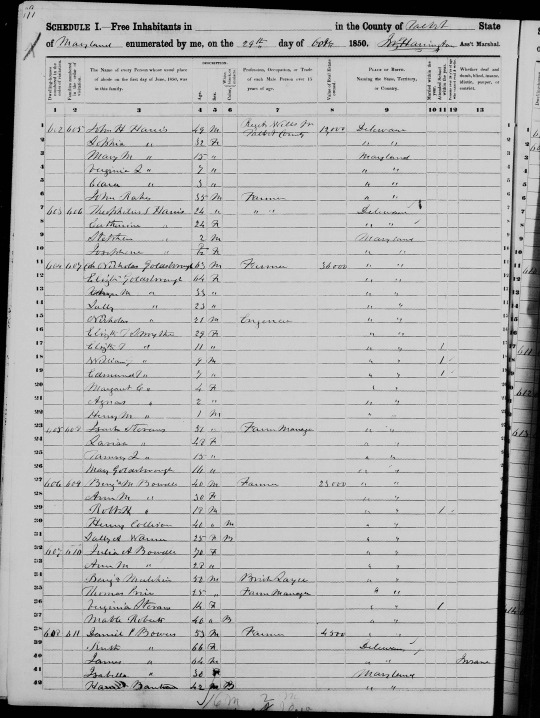
Nicholas is called a Colonel, from what I can see, and is a farmer, with the Symthe family also living with them.
Before this, the 1820 census shows a Nicholas Goldsborough in "Trappe, Talbot, Maryland, United States," the 1830 census show a man of the same name in "Talbot, Maryland, United States" while the 1840 census shows a man by the same name in "District 3, Talbot, Maryland, United States." One can say these men are the same and that they are undoubtedly Elizabeth's husband of the same name. Additionally, it is likely that Elizabeth was living with him. Other records, within the 1850 "slave schedules" show that her husband is clearly a slaveowner, of at least three individuals. Hence, the Tilghman family could not escape slavery and was part of it without a doubt.
It is hard to say when Elizabeth married Nicholas. I say that because the 1800, 1810, 1820, and 1840, censuses show a woman named "Elizabeth Tilghman" in Talbot County, alone. Likely the "Mariah E Tilghman" in the 1840 census is Tench (the 1st)'s wife.
The story of Henrietta Maria Francis
As I noted in my post last week, a woman named Henrietta Maria Francis was first "acquainted" with Tench (in 1780), when she was age 25, and married the uncle of Tench, in 1783, with Tench visiting them after their marriage. She said in her deposition in the pension that:
...she intermarried with Philip Francis, the uncle of the said Tench Tilghman in the year seventeen hundred and eighty and was in the year seventeen hundred and eighty three was living near Eden Park, near the town of Wilmington, in Delaware, and that the said Col Tench Tilghman, before his marriage, and in the month of March of March seventeen hundred and eighty three made a visit to the despondents husband, at [Eden Park]
One history of Tench seems to mention this Philip fellow, saying that he is the brother of Anna Francis, the wife of James Tilghman, Tench's father, while another individual, "Tench Francis" is mentioned as Tench's uncle. Find A Grave is no help in this regard, only finding three individuals with the name of "Tench Francis." Other searches note a man named "Sir Philip Francis" but it not known of this is the same as Henrietta Maria's husband. The Wikipedia page for Tench Francis Sr gives the biggest clue:
Tench Francis (born probably in Ireland; died 16 August 1758) was a prominent lawyer and jurist in colonial Maryland and Philadelphia, Pennsylvania...In 1724 he married Elizabeth Turbutt. Together, they had [a number of children including] Philip Francis, who married Henrietta Maria Goldsborough, who were the grandparents of Philip Francis Thomas...[and] Ann Francis, who married James Tilghman, who were the parents of Tench Tilghman...Tench Francis died in Philadelphia in 1758.
So, Henrietta Maria's maiden name was Goldsborough and her husband, Philip Francis, had the same father as Tench's mother, Ann Francis. Searching for "Henrietta Maria Goldsborough" turns up varied results on Find A Grave so it is not known which, if any, are the same as Philip's wife. The same can be said for the results on Family Search. Tech does seem to call him "Phil Francis" in 1776 so perhaps Henrietta did know Tench well.
Conclusion
The Tilghman family is a gift that keeps giving for research, one that can continue to be mined for research. For now there won't be a follow-up article, but if anything else comes up in the future, an article adding to previous documents may be released. As always, I look forward to your comments.
© 2017-2023 Burkely Hermann. All rights reserved.
Continued in part 2
#tilghmans#ancestors#ancestry#genealogy#family history#white history#tench tilghman#peale#george washington#census#talbot county#farmers
0 notes
Text
Here’s my top 10 since people are doing it :)
1. Lasko Moore (my introduction to redacted and is my all time favorite boy, love him to pieces)
2. Milo (Anthony) Greer (god I am a sucker for men with a Boston accent. Big smooch to him)
3. Flyboy!Ivan (overall amazing sweetheart when not possessed by a demon of sadism)
4. Gavin (my favorite pink amorphous being, great stand in for transgenderism. Definitely listens to Days of Girlhood by Dylan Mulvaney)
5. Fool!Gavin (GAVIN IN HIS BOYLOSER ERA, stunning, gorgeous, smooch)
6. Huxley/Damien (literally couldn’t pick who to put over the other, it would hurt my soul. My favorite boy kissers)
7. Asher Talbot (for sure listens to Avril Lavigne, breath always smells like skittles and monster energy, cutie pie)
8. Guy (silly goofy dude, have to be in the right mood to listen to him, but when I am I am)
9. David (took me a hot minute to warm up to David especially with his older videos, but he slaps and his proposal vid and BA makes me fold)
10. Sam (once again took some time to warm up to him, was never a huge fan of county boys up to this point. His newest BA is very hot tho 10/10)
#redacted asmr#redacted audio#redacted lasko#redacted huxley#redacted damien#redacted flyboy!ivan#redacted gavin#redacted fool!gavin#redacted david#redacted sam#redacted guy#redacted asher
29 notes
·
View notes
Text



Maryland Flag Wars: Round 1, Bracket 2
11 notes
·
View notes
Text
On St David's Day and celebration of Welsh heritage and culture. I needed to see this clip today. It feels so fitting to what's going on in the world right now…
Richard Burton reciting from Shakespeare's
"What a piece of work is a man" monologue, in Hamlet. When he did this on stage in 1964, it would have been booming out through the Broadway venue, but there's something equally powerful about hearing him recite it in a more understated way, in close-up.
He was noted for his mellifluous baritone voice. Burton established himself as a formidable Shakespearean actor in the 1950s and gave a memorable performance as Hamlet in 1964. He was called the natural successor to Sir Lawrence Olivier.
Richard Burton CBE. The Welsh actor was born Richard Walter Jenkins Jr. 10th November 1925 in Pontrhydyfen (or Pont-rhyd-y-fen) is a small village in the Afan Valley, in Neath Port Talbot county borough in Wales 🏴 and educated in Exeter College, Oxford. He died on 5th August 1984 (aged 58) in Céligny, Switzerland 🇨🇭 His burial place - Old Cemetery ("Vieux Cimetière") of Céligny.

#RichardBurton recites from #Hamlet #actor #StDavid'sDay #Shakespeareanactor #voice
@shinycomputerqueen “Some are born great, some achieve greatness, and some have greatness thrust upon them"...William Shakespeare,Twelfth Night, Act II, Scene V. With his magnificent voice and presence, Burton was one of the major actors of the 20th century.

9 notes
·
View notes